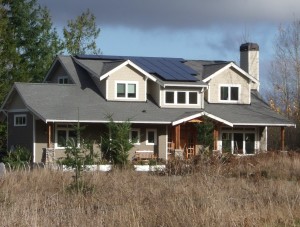
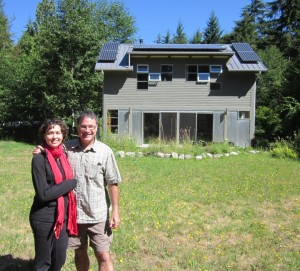
We are glad you are taking the time to review this list of frequently asked questions. The most common question we are asked is, “I’m interested in solar power for my home (or business), but I’m not sure if it really works here or what it costs.” We’ll answer these and many other commonly asked questions. After reviewing this information, you’ll be much better informed about solar power. When you call us we can discuss your personal situation and you’ll be able to communicate with us at a much higher level.
Before we get started here is a quick guide to some terminology. An individual solar panel can be referred to as a “solar panel” or solar “module.” A number of modules wired together to generate electricity is referred to as a “solar array.” Solar panels that make electricity are referred to as PV modules, short for “photo-voltaic.”
- Does solar work in the “rainy” northwest?
- How does net metering work?
- How can I determine if my home or business is a good candidate for solar power?
- How would the solar panels be attached to my roof?
- What if my roof isn’t sunny? Can I mount a solar array on the ground?
- How much electricity can I expect a solar array to produce?
- How do I determine my power consumption? What are the economics of energy conservation?
- How much will a grid-tied solar electric system cost?
- What financial incentives are available for solar PV systems?
- Are solar modules and inverters being made in WA state and do they qualify for the annual 54 cents per kWh production incentive payment?
- How long do these systems last?
- I’ve heard that PV solar modules require a lot of energy to manufacture. How long does it take for a solar panel to generate the same amount of energy (output energy) that was required to create it (input energy)?
- Do grid-tied solar electric systems require maintenance?
- What happens when the power goes out? Should I invest in back-up batteries?
- I’ve heard about new solar products that are about to come on the market. What can you tell me about upcoming products and technological breakthroughs?
- What are the environmental benefits of PV?
- What is distributed energy?
- How does renewable energy help our local economy?
- How about solar thermal? Can I use the sun to make hot water for domestic use or for space heating?
- What happens when I call Power Trip Energy? What steps will you go through to evaluate my home or business?
- Ok, I’m sold. I want to buy a solar PV system. How does the process work?
===
1. Does solar work in the “rainy” northwest?
First things first, yes, solar power works just very well in our area of Washington State. Here on the north Olympic and Kitsap Peninsulas we average approximately 3.5 hours of full sun per day. That is about 70% of the sun resources of southern California. However, unlike southern California most of our sunshine arrives between March and September when our electricity needs are low, especially for homes designed to not require air conditioning. If your system is tied to the grid, you can sell that electricity back to the Californians during their peak energy usage. For another comparison, western Washington on average receives more yearly sunshine than does Germany on average. This is significant because Germany leads the world in the number of installed solar modules with about 50% of the world’s deployed solar modules. If Germany can effectively utilize solar power so can western Washington. And if we can do it, so can the rest of the United States since most of the U.S. receives even more annual sunshine than we do. The bottom line is solar power is the most practical way to make renewable energy for a home or business. The following questions and answers will help explain why this is true.
2. How does net metering work?
Our state’s Net Metering law was originally passed in 1998. All utilities in Washington State are required to allow their customers to install solar photovoltaic (or PV for short) renewable energy systems and provide “net metering” to their customers. Net metering allows you to use the solar electricity your system is generating and to sell any surplus to the electrical utility at the same retail rate they charge you for their electricity. Net metering regulations have dramatically improved the average person’s ability to create and use their own solar power. Here in the northwest our peak energy usage is typically during the wintertime when the days are shortest, while our peak sunny days and highest solar production occur in the summertime. With net metering, it doesn’t matter. Net metering allows us to earn credits on our monthly utility bills in the summertime with our grid tied solar PV system and use those credits in the fall and winter as the days get shorter and our energy needs start rising again. During the winter when your solar PV array isn’t producing as much power as your home or business requires, the grid provides steady, reliable power.
In this way, we are using the grid as a “virtual battery.” This virtual battery has many advantages over having an actual physical chemical battery in your home.
- It is infinitely sized, at least practically infinite relative to our 5-25 KW residential grid-tied pv system. Our solar electricity will never “fill” the grid, unlike an actual off-grid battery bank which may be at full charge early on a summer morning, not giving us anywhere to store our summer day’s energy unless we make certain to use the energy at the same rate at which it is being produced.
- It is 100% efficient. Energy stored in the form of a kwh (kilowatt-hour) credit on your meter is later used, and because there is no conversion from electrical to chemical energy and back, there is no loss due to inefficiency.
- We can seasonally store energy. There is no loss of energy over time when it is stored as a credit on your meter. You can use summertime energy in the wintertime when you need it most and your array is not producing as much power.
- You already pay a small monthly fee for the use of the grid. The grid construction and maintenance is a socialized cost shared by all utility customers, you will see you monthly service charge on your existing bill. This flat fee ranges from about $12 per month in progressive utilites, up to nearly $48 per month in utilities that keep kwh rates low by using high flat fees.
Here is the underlying RCW 80.60: http://app.leg.wa.gov/rcw/default.aspx?cite=80.60
3. How do I determine if my home or business is a good candidate for solar power?
We can formally determine the potential of your home or business for solar power through a site evaluation of your home or business (see #20 below). We are also happy to speak to you over the phone at no charge and look at aerial photos of your home using Google Maps or Google Earth. We’ll give you some basic facts now so that you can get a feel for your site’s solar potential. First, sunshine is your fuel so you need a sunny roof for a roof mounted PV system or a sunny area on your property for a ground mounted array. Solar panels don’t work in the shade. So, what do we mean by “sunny?” During a solar site evaluation we will accurately measure your site’s annual solar resource with the click of a button on our solar SunEye.
Sites with year-round sunshine (from about 9 am – 3 pm) are generally good solar candidates. A little morning, evening, or wintertime shading can be tolerated and can still have good overall PV performance. A south facing roof is the best orientation for a roof mounted system and the best roof pitch for year-round PV performance is 5:12 to 12:12. However, if your roof is steeper or shallower or if you have an east or west facing roof – DON’T PANIC! Sunny, south facing roofs with a roof pitch shallower than 5:12 or steeper than 12:12 are still excellent solar platforms. The difference in production on a 3:12 roof compared to a 5:12 roof is only about 3.5%.

Chris and Carolyn Eagan’s home has an excellent sunny, south facing roof with a relatively low pitch (3:12) now outfitted with a 7.2 kW PV system.
East or west facing roofs, if relatively unshaded, also serve as excellent solar platforms. A roof can be oriented up to 30 degrees east or west of due south and lose only about 5% of the potential solar gain. If you have an east or west facing sunny roof, the shallower the roof pitch, the better for overall solar gain. In determining the location and design of a solar array, our goal is to locate your solar array where it will generate the most power over the course of the year while looking attractive and intentional on your property.
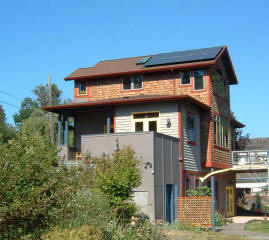
Jeff and Shelly Randall’s home in Port Townsend utilizes their west facing roof to generate electricity from the sun with a 2 kW PV system.
If you have a flat roof it is possible to orient the panels south through the use of a fixed tilt racking system. This is typically the only situation where we will tilt or “rack-up” a solar array. Normally a solar array is “flush mounted” parallel to match the pitch of the roof.

This Bremerton duplex utilizes its flat roof with full sun exposure to generate electricity for its occupants.
As a general rule of thumb, it takes approximately 50-65 sq. feet of roof area to accommodate 1 kW of PV array. Solar panels are roughly 40″ inches wide by 73″ high and each module generates approximately 420 watts.
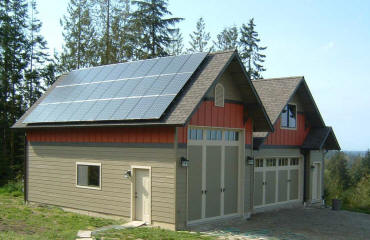
4. How would the solar panels be attached to my roof?
Every type of roof has the manufacturer’s approved methods of penetration and sealing. With the experienced gained from over 1200 rooftop solar pv installations, we have most likely worked with your type of roof many times.
We attach our solar arrays to the structure of the roof using equipment specifically designed for the purpose. Heavy duty lag bolts attach the array to the roof framing. The roof penetration is sealed and flashed with the appropriate type of materials depending upon the type of roof we are working on. If you look at your own roof you will see roof vents, plumbing vents, skylights, etc. all safely installed and sealed. The equipment that lies between your solar modules and your roof is made of stainless steel, aluminum, or galvanized steel to prevent rust and all components are engineered by the manufacturers to withstand wind speeds in excess of 125 mph.

Aluminum rail, standoffs, and heavy duty stainless steel lag bolts hold the solar array to the roof. Flashing and sealant used at each point of roof penetration ensure no leaks on composition asphalt shingle roofs.
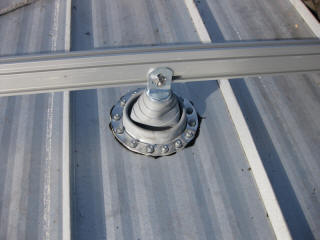
On metal roofs Deck-tite style flashings are sometimes used over the standard metal standoffs to prevent any roof leaks and ensure a strong attachment can be made to the roof structure. These flashings are warranted for 25 years.
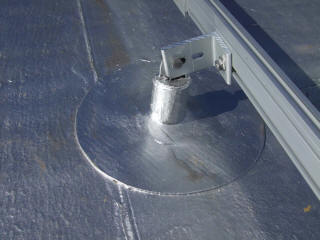
On a flat roof, the standoffs are attached to the roof structure and sealed before the rails are attached.
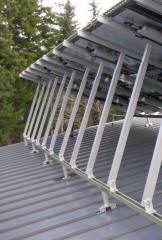
Standing seam roofs are sometimes suitable for S-5 clamps. This array is a bit unusual as it is racked up on a reversed pitch (north facing) shed roof and uses a combination of S-5 clamps plus a number of Unirac FastFoot mounting plates.
Power Trip Energy has successfully installed solar PV arrays on many types of roofing including standing seam metal, asphalt composition shingle, concrete tile, aluminum shingles, plywood sealed with fiberglass, rolled asphalt (flat), corrugated metal, and commercial grade white membrane (flat). We have the experience gained from over 1200 rooftop installations and we are confident we can work safely on any roof surface that is a good location for a PV array.
5. What if my roof isn’t sunny? Can I mount a solar array on the ground?
Yes, if a roof has too much shade or is otherwise not appropriate for a solar array, a ground mounted system is often a good solution. We have had customers who take this as an opportunity to build that tool shed they always wanted but with a roof designed specifically for a PV array.
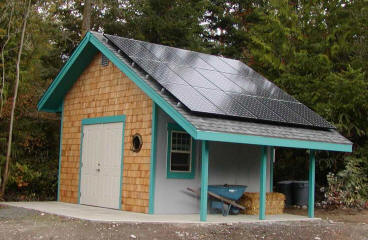
3 kW on tool shed roof in Sequim Bay area built specifically as a platform for the solar array. The power from this system is transferred to the nearby home’s service panel. We have trenched power in this manner up to 650 ft.
Alternatively, Power Trip Energy can install your PV array on a pole or multi-strutted ground mount structure. Ground-mounted PV is more expensive as compared with a roof mounted array because of the need for structure, trenching, and in some cases, additional fencing.
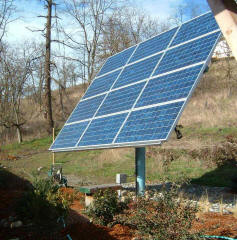
Pole mounted PV array in Sequim. Poles work best when a small PV footprint is desired. Trackers can be utilized on this type of array but increase the cost and complexity of the system.
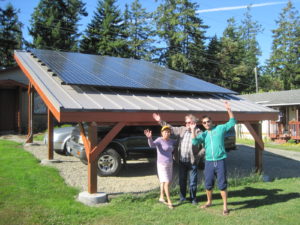
The Morgan family built a car port specifically sized for their vehicles and their solar array.
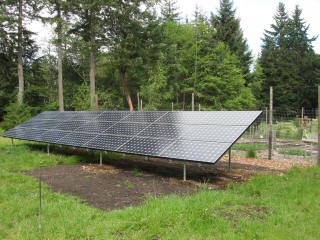
This ground mounted array on Bainbridge Island uses 2” heavy duty galvanized pipe. This type of structure works well for large ground mounted systems and is adaptable to uneven terrain.
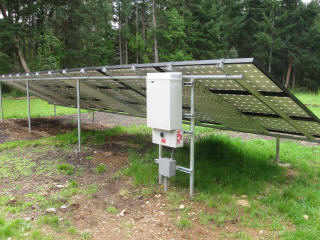
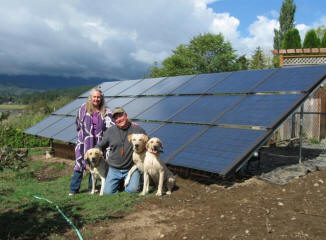
Ground mounted 3.7 kW Silicon Energy array in Quilcene, WA.
6. How much electricity can I expect my solar array to produce?
Ok, so you’ve got a sunny spot picked out. How much electricity over the course of an average year can you expect to generate with your solar PV system? Are you ready for some math? Every 1 kW of installed solar panels generate approximately 1,000 to 1,200 kilowatt hours (kWh) of electricity annually on the north Olympic and Kitsap Peninsulas (1 kW installed = 1,000 to 1,200 kWh/yr). Sites with full sun where the solar panels are oriented due south should expect to be at the upper end of this range. Calculate your roof area (50 – 65 sq. ft. of roof area required per kW of PV array) and multiply it by this figure and you’ll have an idea of the annual electricity a PV system on your roof could generate. Shading will decrease this output based on the percentage of shade a location receives through the year. Why focus on the amount of electricity per year as opposed to per day? Here in the northwest, we receive very different amounts of sun in the summer vs. winter months. So rather than try and estimate per month production we focus instead on a yearly average. With net metering the total power generated over the course of the year is what matters.
7. How do I determine my current power usage? What are the economics of energy conservation?
You should review your electric bill to get an idea of how much electricity you are currently consuming over the course of the year. Your utility bill will express your energy consumption in kilowatt hours (kWh) per day, month, or year (typically referred to as average daily consumption). You may be surprised to see how much energy you use and how big a solar PV system you would need to satisfy 100% of your energy needs. As you consider generating your own renewable energy, you should also consider reducing your overall power demand through conservation. On average, it is 3 – 5 times cheaper to save a watt of energy through conservation than it is to generate that same watt of energy through solar power.
Conservation techniques include designing your home to take advantage of passive solar for both heating and natural light, energy efficient appliances such as Energy Star Certified, super insulation and high efficiency windows and exterior doors, and compact fluorescent light bulbs which are 80% more efficient than incandescent bulbs and LED bulbs are 90% more efficient than incandescent. Other conservation techniques include utilizing a solar dryer (a fancy name for a clothesline) and the elimination of phantom loads (appliances that use power even when not in use) by installing power strips or kill switches.
8. How much will a grid-tied solar electric (PV) system cost?
Typical costs range from $2,500 – $3000 per installed kilowatt (kW) after the 30% federal income tax credit. Because each system has common components, the larger the system, the lower the cost per kilowatt. These components include solar panels which generate the power (about 60% – 70% of system cost), an inverter or micro-inverters which convert the DC power produced by the solar panels to AC power that can be used by your home and the utility grid, one or more safety disconnect switches which isolate your solar panels if they require maintenance, wiring, racking for the solar panels, and finally the cost of installation. The larger the system, the greater percentage of the budget goes to your solar panels and the lower price per kilowatt you can achieve.

From left to right: SMA 7000 watt grid tied synchronous inverter with integrated DC disconnect, system production meter above the AC disconnect (middle), and the utility revenue meter (pre-existing) which has been retrofitted by the utility to be a net meter capable of metering both incoming and outgoing electricity. Not pictured is the home’s electrical panel (inside) behind the utility net meter where the PV system interconnects with the grid via a two pole breaker.
9. What financial incentives are available for solar PV systems?
There is a 30% federal income tax credit on the total cost of the system, including installation (authorized through December 2032).
Several financial incentives exist which boost the value of the electricity that is generated by the grid tied PV system. The first is called net metering. Washington State law requires all utilities to allow their customers to interconnect their renewable energy system to the grid (subject to connection rules) and receive credit for electricity generated at the same retail rate they charge their customers.
Direct links to more information on the current state of the financial incentives is located on the Power Trip Energy Financial Incentives Page
10. Are solar modules and inverters being made in WA state?
Silicon Energy began making modules and inverter assemblies in Marysville, Washington in 2010, and ceased production in 2014. Itek began making pv modules and assembling inverter components in Bellingham in 2012 and was purchased by SilFab in 2018.
There have been several different inverters assembled in Washington over the years.
We currently do not offer made-in-Washington products.
11. How long do these systems last?
The REC modules we use carry a 25 year warranty, but what is their overall life expectancy? While it is hard to know for sure, REC rates their systems to last for 40 years. Solar panels constructed by Bell Labs in the 1950s are still working today, that’s over 70 years of production. REC has created an AC module that carries the 25 year warranty on the module as well as the microinverter, and as the entire system contains no moving parts, it is built to last. REC modules have a guarantee of 92% power output at 25 years, where as other solar modules are around 87% at 25 years. This is by far the best warranty available for the power guarantee, longevity, and for the details of costs covered by the manufacturer. We sell the highest quality components so that we (and you) can sleep well at night. If you have a problem with your system, we’ll be there to take care of it – Power Trip Energy Corporation has been thriving for 23 years now, with 2022 being our best year to date, in terms of kW installed.
Here is an anecdotal article by Martin Holladay who several years ago tested his 30 year old PV module. http://www.greenbuildingadvisor.com/blogs/dept/musings/testing-thirty-year-old-photovoltaic-module.
12. I’ve heard that PV solar modules require a lot of energy to manufacture.
How long does it take for a solar panel to generate the same amount of energy (output energy) that went into its manufacture (input energy)? A recent study by the National Renewable Energy Laboratory conclusively demonstrates that energy payback for photovoltaic panels is approximately 1-4 years. Given that PV module lifetimes are generally in excess of 30 years, a PV system will produce far more energy than went into its manufacture over its lifetime. Technological progress in the years since the issuance of this report has tended to bring down the energy input of PV manufacturing yet further, as solar cell manufacturing processes become more efficient. For more information about this and other “myths” of solar, please see: http://NREL Life Cycle Assessment of Photovoltaic Technologies (PDF).
13. Do grid-tied solar electric systems require maintenance?
Solar grid-tied PV systems have no moving parts and are nearly maintenance free. The tempered glass surface of the panels naturally shed water (and any accumulated dust) and are about as tough as a car’s windshield. Manufacturer’s rate solar panels to withstand 1” hail at 90 mph (hopefully we’ll never see hail that big here!). We mount the modules about 3 – 4 inches above the surface of your roof so that stray branches or leaves will not be trapped under them and to allow natural air circulation under the panels keep them as cool as possible thereby boosting electrical output. In a particularly dirty or dusty location, it can’t hurt to clean the modules during a period of dry weather when there is no rain to take care of this chore. Most of our clients do not bother with this task. With grid tied PV there isn’t much to do except read your meter and inverter and watch your kilowatt hours of renewable energy add up.
14. What happens when the power goes out? Should I invest in back-up batteries or a generator?
In the case of a power interruption, the inverter is designed to immediately shut down. This is a safety measure built in to ensure that during a blackout your solar array will not back-feed the grid and potentially injure utility service personnel. If you are interested in having a back-up power source in times of extended power outage, we recommend you consider giving us a call so that we can help you find the right solution. While some energy storage solutions can be recharged by a standby generator in the event that your solar array is unable to keep up with the power demand of your home during an outage; others cannot. Fear not, there’s always a solution and we are going to help you find the right solution for your particular situation. A few things to consider before we talk would be: what electrical loads you want to back up during an outage and how long do you want the energy storage systems to power your backed up items?
Technology has come a long way in the past three to four years and we are excited that it finally makes economic sense to invest in energy storage solutions for the average homeowner. The ability to create your own micro-grid during utility-based outages can be a lifesaver for some individuals with health care struggles or those who simply want to be self sufficient. Working together, we can help you build a robust energy storage system for your home or business.
15. I’ve heard about new solar products are about to come on the market. What can you tell me about upcoming products and technological breakthroughs?
This is a question we get a lot, “Should I act now or wait for the big breakthrough in solar that I hear is coming?” Keep in mind that solar PV is now a mature technology. Solar panels were first developed in the 1950s and their price per watt has dropped from $1,400 per watt in the 1950s to around $3 – $4 per watt today. Solar PV manufacturers include companies recognizable in the electronics industry such as LG, REC, and Maxeon. While solar PV manufacturers today continue to make improvements in efficiency and strive to cut costs, these improvements tend to be incremental.
Here at Power Trip Energy, we receive press releases nearly every day about new developments in solar technology, usually focused on improved efficiency or decreased cost. We have been seeing reports like these since our business was first established in 2003 and they are increasing in frequency as solar gains momentum. Most of these reports originate from commercial laboratories or academic institutions and are likely designed to generate more research and development funding. Keep in mind that products are always evolving and we will continue to look for better and more efficient products to offer our customers.
Recently, thin film (amorphous) PV technologies claimed imminent savings in the cost per watt. The challenge with thin film modules is they are much less efficient in terms of watts per square foot (about 8% – 10%) than conventional framed modules. Recent failures by thin-film manufacturers such as Solyndra and Unisolar, seem to indicate that thin-film solar will only be competitive in narrow market segments. On a commercial or utility-scale, thin film may be a better option if the price per watt is lower and roof space or land area is not a limiting factor. However, on the typical residential roof our goal is to generate as much power as possible in a finite space.

1.3 kW thin film PV array (dark area on barn) at Wildberry Farm owned by the Cochrane family. If we had used framed modules we could have fit 5 kW in this same area.
So, to wait or not to wait, that is the question. There are several reasons why we do not recommend waiting for the “big breakthrough.” If you are building a new home or business, it is best to capitalize the solar aspect concurrent with the rest of the project, as there are excellent financial incentives available right now. A second reason is that acting means changing the status quo. We are contacted by more than a few folks interested in solar but reluctant to act, expressing the desire to wait and see what comes. Our experience has been that these folks don’t ever seem to find what they are waiting for.
Changing the status quo does not come easy. We think that American’s tendency to wait for something better to come along and continuing the status quo has gotten our society to its present energy and economic situation, which to us is unacceptable. We want to change the way America makes its electricity. Our sights are set high. If you have the ability to move ahead with your PV system now we urge you to do so! We hope to see continued increases in efficiency and decreases in PV pricing. But we also think that 5 or 10 years from now if you hear about such developments, you will not feel disappointed that you acted too soon, rather you will take pride in the fact that you have helped bring about this progress.
16. What are the environmental benefits of PV?
Solar electricity generated at your home or business is a lot friendlier to the environment than the electricity from the grid, which relies primarily on fossil fuels, nuclear, and massive hydro projects. Fossil fuels contribute significantly to many of the environmental problems we face today – greenhouse gases, air pollution, and water and soil contamination – while renewable energy sources contribute very little or no pollution. The use of fossil fuels has significantly increased greenhouse gas emissions creating an enhanced greenhouse effect known as global warming. Renewable energy technologies, however, can produce heat and electricity with a very low or no amount of carbon dioxide emissions. * Other equals biomass, landfill gas, petroleum waste, wind and solar.
Also, here in the NW, we are especially aware of the damage done by hydro-power producing dams, as they are the major factor in the devastation of one of our most valuable resources, the native salmon runs. The loss of salmon has decimated the NW fishing industry and has had significant negative impacts to local Native American cultures.
17. What is distributed energy?
Solar PV grid tied systems are examples of distributed energy systems. Instead of the electricity being generated at a far away power plant and transmitted by high voltage power lines, the power is generated at the point of use on the roof of the home or business. Grid tied systems first supply energy to the home or business where they are located and excess electricity is fed back to the grid for use by other consumers. Typically, no improvements need to be made to the utility lines to accept the back-fed power from grid tied systems. Grid tied solar PV systems can turn every sunny roof into an electrical generation plant. No one has to deal with pollution from smokestacks or the nightmare of nuclear accidents or storage of radioactive waste. Because PV arrays only make electricity during the daytime, grid tied solar power must be complemented by other power sources that can be brought on line as needed. With our country’s increasing need for energy, we feel that grid tied solar PV will be an important part of the solution and once widely deployed will offset the need for new coal fired or nuclear power plants.
18. How does renewable energy help our local economy?
In Washington, we rely heavily on energy produced from natural gas and coal, both imported from out of state, to provide our electricity. The cost of these fossil fuels can add up to billions of dollars. And every dollar spent on imported energy is a dollar lost from our local economy. Renewable energy resources are developed locally, literally converting our local sunshine into electricity and dollars. The dollars spent on energy stays in our local economy, creating more jobs and fostering economic growth.
Renewable energy technologies are labor intensive. Jobs result from the manufacture, design, installation, servicing, and marketing of renewable energy products. Jobs even arise indirectly from businesses that supply renewable energy companies with raw materials, transportation, equipment, and professional services, such as accounting and clerical services. In turn, the wages and salaries generated from these jobs provide additional income in the local economy. Renewable energy companies also contribute more tax revenue locally than conventional energy sources.
19. How about solar thermal? Can I use the sun to make hot water for domestic use or for space heating?
Solar thermal systems heat water using the sun’s heat. There are many solar thermal technologies in use around the world. Here in the northwest where we can get freezing weather in the winter and cold temperatures regularly at night, most systems utilize flat plate or evacuated tube collectors, internal insulated storage tanks, and closed loop circulation systems that glycol antifreeze.
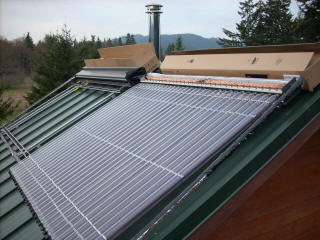
Two evacuated tube collectors being installed on the roof of a Port Angeles area home.
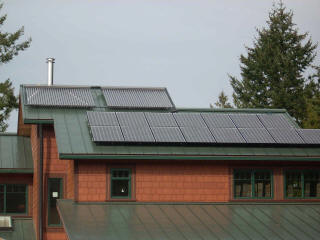
The completed system. The evacuated tube collectors are on the upper part of the roof and two rows of Sanyo PV modules are located below. The two solar systems work independently.
Solar thermal systems use a collector (flat plate or evacuated tube) to collect the sun’s energy and heat water that is pumped to the collector using electric pumps. A tank is needed to store the hot water generated by the system, insulated plumbing transmits the water to and from the collectors and a pump and control equipment manage the movement of the heated water. These systems can be used to preheat water before it enters the home’s water heating system (back up water heating is needed for winter time, nights, and cloudy weather) or can be expanded to help with space heating needs.
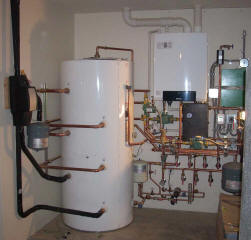
A nearly complete integration of a solar thermal system. A 120 gallon storage tank is on the left. Note the plumbing entering the tank. This tank contains three heat exchange loops, one for the solar thermal (bottom) one for the back up heat source (middle) and one to the radiant floors (top). An on-demand propane boiler provides back up heat. Other equipment includes the floor radiant heat controls.
The most practical use of a solar thermal system is to preheat domestic hot water. Most homes use a fairly consistent amount of hot water throughout the year for bathing, drinking, clothes washing, etc. A solar thermal system can be designed to meet roughly 100% of a home’s typical hot water needs in the summer and much less during other parts of the year (again, the need for the backup water heating source).
The energy savings comes in the form of electricity or propane saved by heating the water with the sun. Using solar thermal for space heating is more complex than domestic hot water use alone because the solar thermal systems must be bigger and more powerful. In the northwest we typically need to heat our homes from late fall through early spring, corresponding to exactly when we have the least solar resource to work with. A different problem arises in the summertime when a solar thermal space heating system can generate more heat than the home uses and the tanks can safely store. This excess energy will need to be dumped into an outdoor concrete slab or blown into the air using a fan and exterior radiator.
Does this sound like a lot of money to spend on equipment that doesn’t work efficiently most of the time? We think so. We feel that this money would be better spent in generating electricity via solar PV, that could then be used by electrical heating equipment (a heat pump or electric on demand boiler).
When compared to solar PV, solar thermal has some disadvantages. The first is there is no net metering. If you make more hot water than you use the utility will not pay you for it. To save money you must use the solar hot water when it is available thereby reducing the amount of energy you would have used to heat the hot water. Your time of use must correspond to when the solar heated water is available. The second disadvantage is that solar thermal systems require regular maintenance for proper operation. There are moving parts (pumps, etc) that must be periodically maintained or replaced, antifreeze coolant annually checked and replaced if needed, and extreme hot or cold weather requiring management of the system to deal with excess heat or freezing temperatures. These systems will fail if not properly maintained. If you own a solar thermal system you must be an active participant in its successful operation.
Currently, Power Trip Energy is not installing solar thermal systems, though we have installed or participated in the installation of 15 of these systems. If you are interested in solar thermal in addition to PV, we will evaluate your home for both during our site evaluation process (see below) but we cannot install these systems for you at this time. We have often heard people say they have heard that the “payback” is faster with solar thermal systems. This is no longer true (if it ever was). The efficiency and decreased costs of PV make it more attractive in both the near term and the long haul.
20. What happens when I call Power Trip Energy?
What steps will you go through to evaluate my home or business? When you call our office we’ll answer your remaining questions about grid-tied solar PV. We can also look at your home’s roof using aerial photography on Google Maps to help determine if your home has shading issues. If you are interested in having your home or business evaluated for a solar PV system, we can schedule a site evaluation. During a site evaluation, we will come to your home or business (or vacant lot if you’re planning to build) and we will evaluate the solar potential of your site. We’ll climb on the roof of your house and take the measurements necessary to design your system. We’ll use a solar SunEye and/or pathfinder to accurately assess the orientation and solar potential of your roof or ground mount site. We’ll look at your home’s electrical system to determine how we will connect your solar array to your service panel and the utility grid. We will look at your energy bills to determine how much electricity you are currently consuming and how much of this load various sized PV systems would cover over the course of an average year. Finally, we’ll sit down with you so you can share your goals regarding generating your own green power.
We’ll answer all your questions about costs, financial incentives, location options, various system sizes, maintenance (there really is none), and whatever else you can throw at us. Within a few days of the site evaluation we’ll send you a custom bid for one or more PV system designs and an installation contract. Once you have signed the bid, installation contract, and paid the deposit, we will put you on the installation calendar are we’re typically booked 2 months out on installations.
21. Ok, I’m ready to invest in a solar PV system. How does the process work?
Great! When you are ready to commit to buying a system, we’ll ask you to initial the system bid you are accepting, sign the installation contract, and send us a deposit that equals 40% the cost of the materials. We will then order the solar modules, inverter, and other equipment. When the materials arrive (2 – 4 weeks depending upon availability) we’ll schedule the installation with you. When we deliver the materials to the site you’ll pay us for the remaining portion of the material and shipping costs and we’ll begin to install the system. System installation typically takes 2 – 5 working days depending upon system size and complexity.
Once the system is installed and passes the electrical inspection, you’ll make the final payment to us which covers the installation labor. The cost of the electrical permit is included in the bid, and we’ll take care of the permit, utility contracts, and sales tax exemption forms. We make it easy for you to invest in solar power and to help change the status quo.